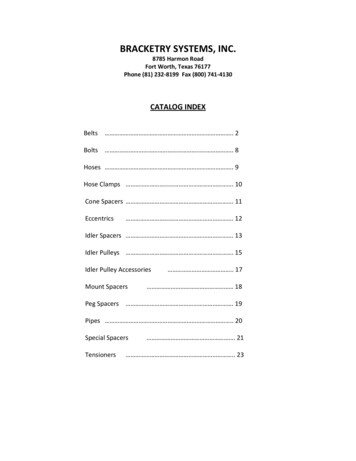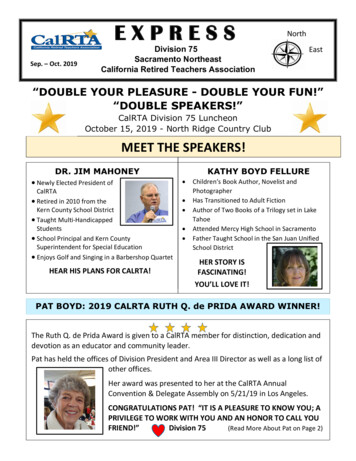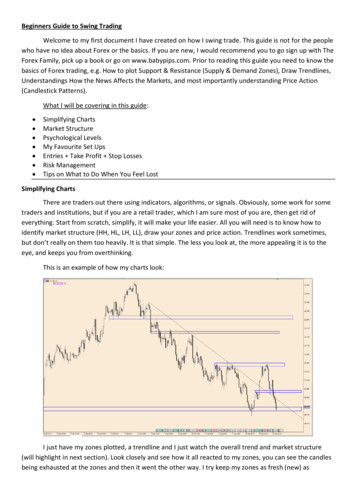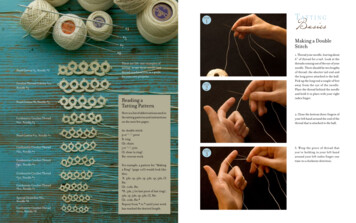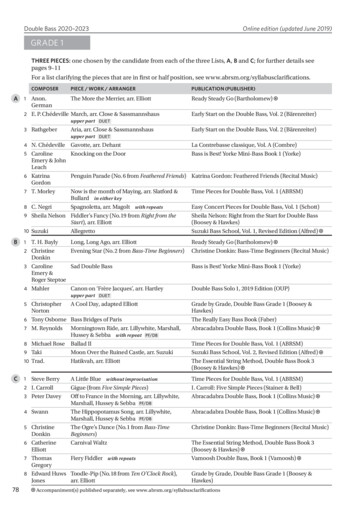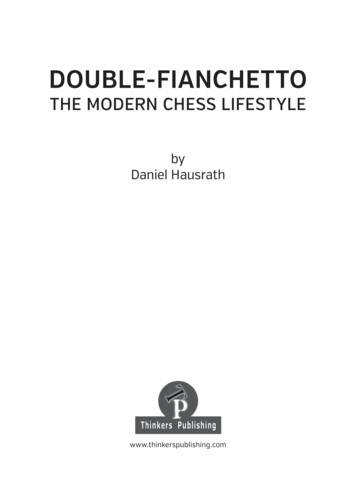
Transcription
DOUBLE-FIANCHETTOTHE MODERN CHESS LIFESTYLEbyDaniel Hausrathwww.thinkerspublishing.com
Managing EditorRomain EdouardAssistant EditorDaniel VanheirzeeleGraphic ArtistPhilippe TonnardCover designIwan KerkhofTypesettingi-Press ‹www.i-press.pl›First edition 2020 by Thinkers PublishingDouble-Fianchetto — the Modern Chess LifestyleCopyright 2020 Daniel HausrathAll rights reserved. No part of this publication may be reproduced, stored in a retrieval systemor transmitted in any form or by any means, electronic, mechanical, photocopying, recordingor otherwise, without the prior written permission from the publisher.ISBN 978-94-9251-075-4D/2020/13730/3All sales or enquiries should be directed to Thinkers Publishing, 9850 Landegem, Belgium.e-mail: info@thinkerspublishing.comwebsite: www.thinkerspublishing.com
TABLE OF CONTENTSKEY TO SYMBOLS5PREFACE7PART 1. DOUBLE FIANCHETTO WITH WHITE9Chapter 1. Double fianchetto against the King’s Indian and Grünfeld11Chapter 2. Double fianchetto structures against the Dutch59Chapter 3. Double fianchetto against the Queen’s Gambit and Tarrasch 77Chapter 4. Different move orders to reach the Double Fianchetto97Chapter 5. Different resulting positions from the Double Fianchetto andtheoretically-important nuances115PART 2. DOUBLE FIANCHETTO WITH BLACKChapter 1. Double fianchetto in the Accelerated DragonChapter 2. Double fianchetto in the Caro KannChapter 3. Double fianchetto in the ModernChapter 4. Double fianchetto in the “Hippo”Chapter 5. Double fianchetto against 1.d4Chapter 6. Double fianchetto in the Fischer SystemChapter 7. Double fianchetto with both coloursConclusion143145153163187205231247273
KEY TO SYMBOLS!?!!?!?! a good movea weak movean excellent movea blunderan interesting movea dubious moveonly move equalityunclear position with compensation for the sacrificed material White stands slightly better Black stands slightly better White has a serious advantage - Black has a serious advantage White has a decisive advantageBlack has a decisive advantagewith an attack with initiative with counterplay with the idea of better is N #worse isnoveltycheckmate
PREFACEFirst of all, I would like to tell the readers something about myself andthe aim of this book. I started playing chess at the age of 4 and wentto my first chess club aged 6. In my youth I was very talented and wonthe German youth championships quite often. I had the opportunityto play several World and European youth championships. My greatestachievement was equal second place at the European under 18 Championships in Greece. Also, I have good memories of the World under12 Championships in Timisoara 1988, where I attained sixth place andwon nice games against the now-strong GMs Almasi and Nisipeanu.At this time also, adjourned games still existed. Before round 10 I had theopportunity to analyze an adjourned game together with the Polgar family,because they would have been happy if I could reach a draw in this game.Daniel Hausrath. (Photo by Ralf Lange)
After analyzing for a long time, we found the way to draw, but the nextmorning I lost that game, despite this analysis. At noon I had to play againstJudith herself and lost a terrible game which is one of my first games in thedatabase now. But I will definitely never forget this story.In the mid-nineties, a Botvinnik chess school was built in Bonn and thestrongest and most talented youth players from Germany had the chanceto learn a lot from the patriarch himself. The first two sessions were headedby Botvinnik and the strong GM Valery Salov, who was one of the leadingplayers at that time.I became an IM in 1997 and a GM in 2013. Many of my students have askedme when I will start writing a book, because they know that I like writing and explaining things. I come from a teaching family; my father wasa teacher at a German academic high school and I always loved and stilllove reading and writing.Nowadays it is no longer easy to find enough silence for reading, becauseI have three small children between the ages of 3 and 6. This book is definitely not a book full of theoretical lines. Of course, I will give some adviceif possible and necessary. But the main purpose is to explain the structuresthat can result from double fianchettoed positions. The reader will find fivechapters with structures from the white side and six chapters with structures from the black side. The last chapter is a mixed one, with games fromboth sides.The main — and longest — part will be the first chapter, with games andanalyses of my own main weapon starting with f3, g3 and b3 against theKing’s Indian and Grünfeld. I will show the reader a few games of my ownand also games from Kramnik and Andersson, two of my favourite players.I have learned a lot from their games myself. I have played those structuresfor nearly 25 years and one of my sons also now starts with 1. f3. During myyears of playing chess I tried many possible openings with White and Black,but I was only successful with fianchettoing one, or even better both, bishops. Maybe this was a sign and those structures are really a lifestyle for me?I hope you will enjoy reading this book and maybe these structures willalso become part of your lifestyle.Daniel Hausrath
PART 1.DOUBLE FIANCHETTOWITH WHITE
CHAPTER 1.DOUBLE FIANCHETTO AGAINSTTHE KING’S INDIAN AND GRÜNFELDThe first game I would like to analyze is a brilliancy from Kramnik.It is always nice when such a genius plays your own openings. I amalways dreaming that he is analyzing my games and thinks that myopenings are so good that he himself has to play this. Unfortunatelythis won’t be the case, but the other way round also works and I really like to get some input from verystrong players.A few years ago there existed almost no theory on the Double Fianchetto structures, but this definitely changed when Avrukhpublished his monumental workscovering 1.d4 in 2010. In chapter 20he analyzed the resulting structuresagainst the Grünfeld in deep detail. After this, those positions wereplayed very often and with good results for White. Later on, Avrukhpublished a new and updated version of his masterpieces.Nowadays we have a lot of books andvideos which show the many linesfor both sides. One of them is thework of Adrian Demuth — his book“The Modernized Reti” — whichI can recommend to readers whowant to really investigate the resulting positions in detail.Let us now start with Kramnik’sbrilliancy! The game against Vocaturo was played at the Baku Olympiad in 2016.1 Vladimir Kramnik (2808) Daniele Vocaturo (2583)Baku 20161.d4 f6 2. f3 g6 3.g3 g7 4. g20–0 5.0–0 d6 6.b3rsnlwq-trk zppzp-zppvlp6 - -zp-snp 5 - - - 4 - -zP- - 3 P - NzP2 P P PzPLzP1 tRNvLQ RmK-87abcdefgh
12DOUBLE-FIANCHETTO — THE MODERN CHESS LIFESTYLEKramnik himself annotated thisgame for ChessBase and here hewrote that he was avoiding the massof theory after 6.c4. It is interestingto read this, because I thought thatI was the only one who had becomeolder and thus wants to avoid mainline theory.rsnl r k 7 zppzp- pvlp6 - - -snp 5 - - - 4 - P p - 3 vLP - NzP2 P - PzPLzP1 tRN R -mK-8a6.e5bcdefgh6.c5 is another principled move,which will be analysed in the nextgame between Kramnik and Caruana.10. c6 This is very logical. 11. c3e4 12. e1 f5 13. ac1 e3 14.f3 witha complicated game, but betterchances for White.7.dxe5 dxe5 8. a311. d4 c6?!Now a typical endgame in thisopening emerges — one that usuallyfavours White. You should not feartrading the queens, because this stillyields substantial winning chances.In such a position it is very important for Black to search for active counterplay. Now White getsenough time to finish his development. It was necessary to start with11. g4 11. g4 12. c3 e3 13.f4c6 14. e4 8. xd1 9. xd1 e8 10.c4Also 10. c3 is an interesting alternative which was played by Kramnik in a blitz game against Vovk inBerlin 2015.12. c3 a610.e4The major problem for Black is thathe has no obvious squares for hispieces. The knight, as awkward as itmight look, is at least aiming for c5.The critical test.13.e3Otherwise White is better developed and will use the d5-square forhis knight.Now White has everything undercontrol and e4 is also something ofa target.
PART 1. DOUBLE FIANCHETTO WITH WHITEr l r k 7 zpp - pvlp6 n p -snp 5 - - - 4 - PsNp - 3 vLPsN-zP-zP2 P - -zPLzP1 tR- R -mK-8abcdefgh13. g4 14. d2 ad8 15.h3 c816. ad1 h5- ltrr k zpp - pvl6 n p -snp 5 - - - p4 - PsNp - 3 vLPsN-zP-zPP2 P -tR-zPL 1 - R -mK-87abcdefgh13a) 17. xe7 is just losing becauseof 18. xc6 xd2 19. xe7 f820. xc8 –;b) 17. d7 leaves Black without thee4-pawn after xf6 and xe4.18. xd4 xe7 19. d8 - ltR- k 7 zpp -trpvl6 n p -snp 5 - - - p4 - P p - 3 PsN-zP-zPP2 P - -zPL 1 - R -mK-8abcdefgh19. e8 19. e8 20. xe8 xe8 21. d8 f822. xe4 e6 23. d6 e7 24. xb7 taking on c6 next.17. e7!20. xe4 e6A nice tactical trick.Kramnik wrote that he couldn’t resist playing this one. Of course, b4was also possible and very strong.17.b4 c7 18.b5 cxb5 19. cxb5 xb520. xb5 xd2 21. xd2 with control of the d-fi le and access to theimportant d6-square.17. xd4 Kramnik admitted that in his calculations his main concern was thatBlack would take on h3, but then hesaw, and gave, the following variation:20. xh3 21. d6 d7 (21. xg222. xe8 f3 23. f6#) 22. xb7 g423.f3 f5 24.e4 e6 25. a5 h726. xc6 c7 27. d4 with a technically winning position.
14DOUBLE-FIANCHETTO — THE MODERN CHESS LIFESTYLE21. a8R - n k zpp -trpvl6 n p l p 5 - - - p4 - P N - 3 P -zP-zPP2 P - -zPL 1 - R -mK-87abcdefghThe point of this combination: Blackhas problems defending his queenside pawns.21. e5 22. dd8 f8 23. xa7Kramnik is well known for his deepcalculations and before his sacrificeon move 17 he thought that he wouldhave a big advantage in this position. The computer shows that thisis not quite so simple and with correct play Black would reach equality.But the good thing is that we are allhuman, and make mistakes!23. c7?23. f5! Threatening to exchangeon e4, followed by . c7. 24. g5 c7! 25. da8 b6 26. xa6! bxa627. xa6 d8 28. xc6 c7 29.h4 c8 30. b6 and also here WhiteVladimir Kramnik, 13tʰ January 2018. (Photo by Frans Peeters)
PART 1. DOUBLE FIANCHETTO WITH WHITEwould retain good winning chances,although the engine gives equality.24. da8! b6 25. xa6 bxa626. f6!R - nmk- - -trp 6 pvlp lsNp 5 - - - p4 - P - - 3 P -zP-zPP2 P - -zPL 1 - - -mK-87abcdefghHere is the difference, and the reason why Black should have played. f5 earlier. The knight doesn’tneed to go to g5 and the resultingpin is now very annoying for Black.26. d7Not nice, but the only move. Otherwise White gets the piece back directly:26.c5 27. c6 –15R - nmk- 7 - ltrp 6 pvlp -sNp 5 - - - p4 -zPP - - 3 - -zP-zPP2 P - -zPL 1 - - -mK-8abcdefgh27. xd7 xd7 28. xc6 d829. xa6 is also very good.27.c5R - nmk- - ltrp 6 pvl- -sNp 5 -zp- - p4 -zPP - - 3 - -zP-zPP2 P - -zPL 1 - - -mK-87abcdefgh27. c7 28.c5! e5 29. xd7 xd730. xc6 e7 31.a4 – and nothingcan prevent White from queeninghis pawns.27.b4!28. d5! c6Very strong!Black is pinned by hand and feet, soWhite has the time and the composure to make progress.28. e6 loses because of 29. b8 a7 30. b7 –29. xa6 xd5 30. xd5 d8 31.b5
16DOUBLE-FIANCHETTO — THE MODERN CHESS LIFESTYLE- -vlnmk- 7 - -trp 6 R - - p 5 PzpL - p4 - P - - 3 - -zP-zPP2 P - -zP- 1 - - -mK-8abcdefg39. xd7 xd7 40. xf7 h4 41.gxh4 d8 42. xg6 –35. c8 d6 36. c6 d8 37.a4 d738.a5 b8 39. b5-snRtr- - P -mkp 6 - -vl- p 5 zPLzp- - p4 - P - - 3 - -zP-zPP2 - - -zP- 1 - - -mK-87hNow White is winning as Blackcannot stop him from pushing hispawns. All of Black’s pieces are badly placed.abcdefgh31. d7A very nice game!31. c7 32. d6 e8 33. c6 e734. d7 e6 35.a4 –Showing some of the tactical opportunities that are made possibleby better development and more activity!32.b6 e7 33.b7 c7 34. a8R - n - 7 Pvlrmkp 6 - - - p 5 -zpL - p4 - P - - 3 - -zP-zPP2 P - -zP- 1 - - -mK-8abcdefgh34. f634. d8 35.a4 d6 36.a5 xb737. a7 xa5 38. xb7 d71–0This next effort was one of my firstdouble-fianchetto games. It wasplayed in Budapest at one of the legendary First Saturday tournaments,a closed round-robin event.After finishing school I played a lotof tournaments and in BudapestI made my first IM norm with 11out of 13. Perhaps this game was thestart of my love for the double-fianchetto structures.
PART 1. DOUBLE FIANCHETTO WITH WHITE2171. f3 f6 2.g3 g6 3.b3 g7 4. b2d6tage. The d6-square is weak andalso the pawn on e5 becomes a target. Sometimes the white knightwill be well-placed on a5 and attackthe queenside. I have played thisposition three times in open tournaments and won all three gamesquite easily.Black adopts a King’s Indian setup.8. c6 9.0–0 gxe5 10.c45.d4 0–0 6. g2 e5 7.dxe5 g4This was the idea behind the queenmove to d2. Now the bishop on b2is protected. Daniel Hausrath (2390) Sandor Farago (2365)Budapest 1996rsnlwq-trk 7 zppzp- pvlp6 - -zp- p 5 - -zP- 4 - - - n 3 P - NzP2 PvLP PzPLzP1 tRN QmK- R8abcdefghA common tactical trick to pushthrough .e5. Usually Black takesback on e5 with the knight to exchange a few pieces in an attemptto equalize.8. d2!?Nowadays I prefer h3. It was oftenplayed by none other than Smyslovin the good old days.8.h3 xe5 9. xe5 dxe5 10. xd8 xd8 11. d2 c6 12.0–0–0 Whitehas a very nice positional advan-10. g4 11. c3 xf3?Black sacrifices his bishop pair in anopen position for doubtful play.12.exf3r -wq-trk zppzp- pvlp6 - nzp- p 5 - -sn- 4 - P - - 3 PsN- PzP2 PvL-wQ-zPLzP1 tR- - RmK-87abcdefgh12. d4My opponent was well-known asa good tactician, but here it is not soeasy to put fire on the board. Normally King’s Indian players want to
18DOUBLE-FIANCHETTO — THE MODERN CHESS LIFESTYLEcreate some unstable positions, butagainst the Double Fianchetto thisis usually impossible.16. ae1 e7-tr-wqr k zppzp-snpvlp6 - -zp- p 5 - - - 4 - Psn-zP- 3 PsN- -zP2 PvL-wQ-zPLzP1 - -tRRmK-8713. d1 e8?!Black should first of all stabilize theknight on d4 with .c5.13.c5 14.f4 ec6 15. d2 It is noteasy to exploit the weakness on d6in this position, but the weakenedwhite squares are a different story.14.f4 ec6 15. d2r -wqr k zppzp- pvlp6 - nzp- p 5 - - - 4 - Psn-zP- 3 PsN- -zP2 PvL-wQ-zPLzP1 tR- - RmK-8abcdefgh17. b5!Exchanging some pieces and putting pressure on the queenside. Italso gets rid of the outpost on d4.7abcdefgh15. b8The main problem in such positionsis to find useful moves as Black.He wants to defend the b7-pawn,but of course this is not the mostactive way of playing. Maybe it wasbetter to play . d7 and connect therooks.15. d7 16. ae1 xe1 17. xe1 e8 17. xb5 18. xg7 xg7 19.cxb5-tr-wqr - zppzp-snpmkp6 - -zp- p 5 P - - 4 - - -zP- 3 P - -zP2 P -wQ-zPLzP1 - -tRRmK-87abcdefghAlthough White has two doubledpawns, his advantage is not in question. He will control the e-file, andthe bishop is much stronger thanthe knight in such an open position. Also, all the black pawns onthe queenside are targets and notso easy to defend.
PART 1. DOUBLE FIANCHETTO WITH WHITE19. g8- r - k 7 - qsnp p6 - -zp- p 5 p - - 4 - -wQ-zP- 3 P - LzP2 r - -zP-zP1 - -tRRmK-8Black wants to play . f5 and exchange a pair of rooks.19. f5? 20. xe8 xe8 21. c3 winning the c7-pawn.20. a5 c6 21. xa7 cxb5 22. d4 a8 23. xb7 xa2- -wqr k 7 L -snp p6 - -zp- p 5 p - - 4 - -wQ-zP- 3 P - -zP2 r - -zP-zP1 - -tRRmK-8a19bcdefgh24. e4?!The pin looks nice, but now Blackcould have taken the chance to develop a bit.Better was 24. e4 controlling thef5-square.24. f8?!24. b6 25. c6 c8 26. d7 cc227. e3 25. d3 d7 26. f3 c8 27. d4 g8abcdefgh28. f6 a7 29.h4 h5 30. d1 d531. fe1- r - k tr- qsnp 6 - - -wQp 5 p p - p4 - - -zP-zP3 P - LzP2 - - -zP- 1 - RtR-mK-87abcdefghNow White has everything undercontrol. All his pieces are workingtogether.31. c6 32. d4 d6 33. e2?!It was much easier to go directly tothe a-file. In time trouble both sidesmade mistakes. In those days wedidn’t play with an increment, andas I remember correctly my opponent had only one minute left. Thisoften leads to the problem that youonly watch the clock and don’t try
20DOUBLE-FIANCHETTO — THE MODERN CHESS LIFESTYLEto find the best moves when the opponent is in deep time trouble. Theworst thing would be to blitz outyour moves as well. It is much moreannoying for him if he has to waitfor your moves for a while.33. f5 34. e5?- - - k 7 tr- q p 6 - -tr- p 5 p pwQn p4 - - -zP-zP3 P - LzP2 - - RzP- 1 - R -mK-8abcdefgh39. e7?The final blunder in a difficult position!39. h6 40. e4 a7 41. d4 40. xf7 xf7 41. xf7 e742. d5 e2 43. c6 b4 44. d7 b245. e6 g7 46. d7 f6 47. c4Definitely not a perfect game, buta nice and important one for getting a norm.1–0334. d3 d4 35. e5 Vladimir Kramnik (2783) Fabiano Caruana (2811)Zürich 201534. a8?34.d4 35. c2 d3 36. c5 d2 Here thed-pawn saves Black.35. xd5 xd5 36. xd5 d8 37. d2 h7 38. d3 e8 39. f6- - r - 7 - q p k6 - - -wQp 5 p L n p4 - - -zP-zP3 P R -zP2 - - -zP- 1 - - -mK-8abcdefghThis was a rapidplay game.1. f3 f6 2.g3 g6 3.b3Here Vladimir played the classicalmove order.3. g7 4. b2 c5 5. g2 0–0 6.c4d6 7.d4 e4!?A very interesting try.Black looks to profit directly fromthe pin on the d4-pawn.
PART 1. DOUBLE FIANCHETTO WITH WHITErsnlwq-trk 7 zpp -zppvlp6 - -zp- p 5 -zp- - 4 - PzPn - 3 P - NzP2 PvL- PzPLzP1 tRN QmK- R8abcdefgh8.0–0 c6 9.h3!?Kramnik wants to prevent . g4ideas.The old main line started with 9. bd2. I analysed the “ugly” lookingmove 9.a3 here which also leads tonice play for White. The idea behindthis move is to protect the b2-bishop with a2 or c2, without givingBlack the chance to attack those pieces with . b4. My first experiencewith this line was also a very funny one. I played against GM Glekin a blitz game at the German teamcompetition on board one with 5minutes each. After a3 he thoughtfor nearly 3 minutes and played. g4, but with 5 versus 2 minutesthere was no chance to hold thegame.a) 9. bd2 xd2 10. xd2 e5!? thisleads to complicated play;b) 9.a3!?21r lwq-trk zpp -zppvlp6 - nzp- p 5 -zp- - 4 - PzPn - 3 zPP - NzP2 -vL- PzPLzP1 tRN Q RmK-87abcdefgh9. g4b1) 9. f5!? 10. a2 cxd4 11. xd4r -wq-trk zpp -zppvlp6 - nzp- p 5 - - l 4 - PsNn - 3 zPP - -zP2 RvL- PzPLzP1 N Q RmK-87abcdefgh11. xf2?! A spectacular sacrificewhich I got in an online blitz gameagainst Cheparinov. First of allI thought that this sacrifice givesBlack an edge, but then I found thefollowing line:[11. xd4!? A much better version for Black, but not yet seen inpractice. 12. xd4 xg3 13. xc6b11) 13.fxg3 xb1 14. xc6 xa2 15. d5 e6 Now Black hasthe main resource . b6 withcheck after f6, because thewhite rook is not on f2. 16. f6?(16. d2! Here also White should
22DOUBLE-FIANCHETTO — THE MODERN CHESS LIFESTYLEhave the better prospects. Onepossible line is: 16.e5 17. e3 xb3 18. b2 a4 19. xb7 d720. xf7 xf7 21. xa8 g722. xf7 xf7 23. xa7 ) 16. b6 ;b12) 13.hxg3 xb1 14. xc6 xa215. d5 a5 16. c2! xa3 17. a1 xb3 18. xa2 xa2 19. xa2 ac8! I would prefer this position as White, but objectively-speaking it should be equal.;13. xf1 14. g2r -wq-trk 7 zpp -zpp p6 - -zp- p 5 - - l 4 - PvL- - 3 zPP - - 2 R - PzPLzP1 N Q nmK-12. xf2 xd4 13. xd4 xb114. xc6! xa2 15. d5 This position seems to be nearly winning forWhite. It is not easy, perhaps impossible, for Black to prevent d2/c1–h6. The bishop on a2 will be alsolost soon. 15. a5 (15.e6? 16. f6 b6 17. d2) 16.e4! e6 17. f3! –r - -trk zpp - p p6 - -zpp p 5 wq- L - 4 - PvLP - 3 zPP - QzP2 l - -tR-zP1 - - -mK-87a8abcdefghFirstly, I thought that thiswould be the easiest solutionfor White — just winning anexchange — but then .e5 wasfound! 14.e5 (14. xh2? 15. xh2e5 16. e3 The main difference;with a knight on f1 this wouldn’tbe possible. 16. h4 17. g1 h318. f1 g4 19. c3 with d2 and d5 coming. Also the g5-squarewould be protected.) 15. c3 xh2 16. xh2 h4 17. g1 h318. f1 g4 ]bcdefghb2) 9.d5! Maybe the best choicefor Black. 10.cxd5 xd5 11. fd2f5 12. c3 xd4 13. dxe4 xd114. fxd1 fxe4 15. xe4 e6 withequal chances;10. c2 f5?r -wq-trk zpp -zppvlp6 - nzp- p 5 -zp- l 4 - PzPn - 3 zPP - NzP2 -vLQ PzPLzP1 tRN - RmK-87abcdefgh11.g4 g3 12.gxf5 xf1 13.d5! I gotthis once in an open tournament ina slightly different way and won easily.
PART 1. DOUBLE FIANCHETTO WITH WHITE9. f5 10.e3 f6?!r -wq-trk zpp -zppvlp6 - nzp-snp 5 -zp- l 4 - PzP- - 3 P -zPNzPP2 PvL- -zPL 1 tRN Q RmK-23the weakness of d4, Black needn’t beafraid of these exchanges.87abcdefghI don’t like to criticize the WorldChampionship challenger, but. f6 looks way too passive. NowWhite can develop in the most active way. I guess Caruana was afraidof h4 getting the pair of bishops,but this wouldn’t be too fearsome.10. c8 11. h4?! (11.g4 e6 12. bd2d5 This move is very often important for Black, attacking the center.13. xe4 dxe4 14. g5 cxd4 15. xe4dxe3 16. xg7 exf2 17. xf2 xg718. f3 - rwq-tr- zpp -zppmkp6 - n l p 5 - - -sN4 - P L P 3 P - Q P2 P - -tR- 1 tR- - -mK-11. c3I often found myself in similar positions and preferred d5 here, gainingmore space.11.d5 b4 12.a3 a6 13. e2 with bd2 and e4 coming11.cxd4 12. xd4 d7 13. e2r -wq-trk zpp lzppvlp6 - nzp-snp 5 - - - 4 - PsN- - 3 PsN-zP-zPP2 PvL- QzPL 1 tR- - RmK-87abcdefghNow we have a normal positionand Black has lost a lot of time with. e4–f6 and . f5–d787abcdefgh.with a complicated position.) 11.cxd4 12. xf5 gxf5 13.exd4 d5 With13.a6 14. fd1 c8 15. ac1 a516.a3White only makes normal movesbut his advantage increases.16. fe8 17.b4 c7 18. b3Now ideas with d5 are in the air.
24DOUBLE-FIANCHETTO — THE MODERN CHESS LIFESTYLE18. b8 19.c5 e6-wqr r k p -zppvlp6 p nzplsnp 5 -zP- - 4 -zP- - - 3 zPNsN-zP-zPP2 -vL- QzPL 1 -tRR -mK-87abcdefgh20. d4 xd4 21.exd4 b3 22. e1e5?-wqr r k 7 p - pvlp6 p -zp-snp 5 -zP-zp- 4 -zP-zP- - 3 zPlsN- -zPP2 -vL- QzPL 1 -tR-tR-mK-8abcdefghNow matters becomes worse, butBlack was always under pressure.A very unpleasant situation, especially in a rapid game.22.d5 It was necessary instead toclose the center.23.dxe5 xe5?Normally one mistake never comesalone!23.dxc5 24.f4 This was better, butof course also not nice for Black.After the game move, however, it islost.24. e4Winning the exchange.24. xe4 25. xe4-wqr - k 7 p - pvlp6 p -zp-snp 5 -zP- - 4 -zP- L - 3 zPl - -zPP2 -vL- QzP- 1 -tR-tR-mK-8abcdefghThe rest is easy.25. e6 26. g2 dxc5 27. e5 a728.bxc5 xc5 29. d4 d7 30. xc5 xc5 31. ed1 h5 32. d5 b5 33. e3- - - k 7 wq- - pvl6 p - l p 5 psnL - p4 - - - - 3 zP- -wQ-zPP2 - - -zP- 1 -tRR -mK-8abcdefgh
PART 1. DOUBLE FIANCHETTO WITH WHITEThis looked like an easy game forKramnik!1–0The next game was played by me inthe Dutch Team Championships.The teams play over 10 boards, andup to 15 minutes before the match itis not clear which opponent will beyours. Normally it makes no senseto prepare against all 10 possibleopponents. This rule makes it easier for players like me to play theirnormal repertoire and have somefun.4 Daniel Hausrath (2507) Lars Ootes (2340)Netherlands 20121. f3 f6 2.g3 g6 3.b3 g7 4. b2d6 5.d4These double-fianchetto structurescan also be called anti-Grünfeld, oras in this game anti-King’s Indian.Both types of players want to geta dynamic battle with attackingchances, but this is nearly impossible.5.c5 6. g2 cxd4 7. xd425rsnlwqk -tr7 zpp -zppvlp6 - -zp-snp 5 - - - 4 - -sN- - 3 P - -zP2 PvLP PzPLzP1 tRN QmK- R8abcdefgh7.d5 8.0–0 0–0 9.c4 dxc4 10.bxc4rsnlwq-trk 7 zpp -zppvlp6 - - -snp 5 - - - 4 - PsN- - 3 - - -zP2 PvL- PzPLzP1 tRN Q RmK-8abcdefghThis ‘tabiya’ — or main starting position — was discussed in detail inthe first volume of Avrukh’s masterpiece covering 1.d4. Of course,his move order was a bit differentand he came to this position via theGrünfeld. The book was publishednearly one year before this gamewas played and I had certainly taken a deep look at the resulting positions. But as often in a chess career,it was also necessary to rememberthe details at the board. Sometimesyou analyze variations but get themonly once in 10 years.
the aim of this book. I started playing chess at the age of 4 and went to my fi rst chess club aged 6. In my youth I was very talented and won the German youth championships quite oft en. I had the opportunity to play several World and European youth championships. My greatest achievement was equal second place at the European under 18 Cham-
